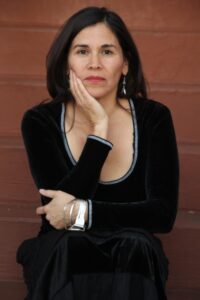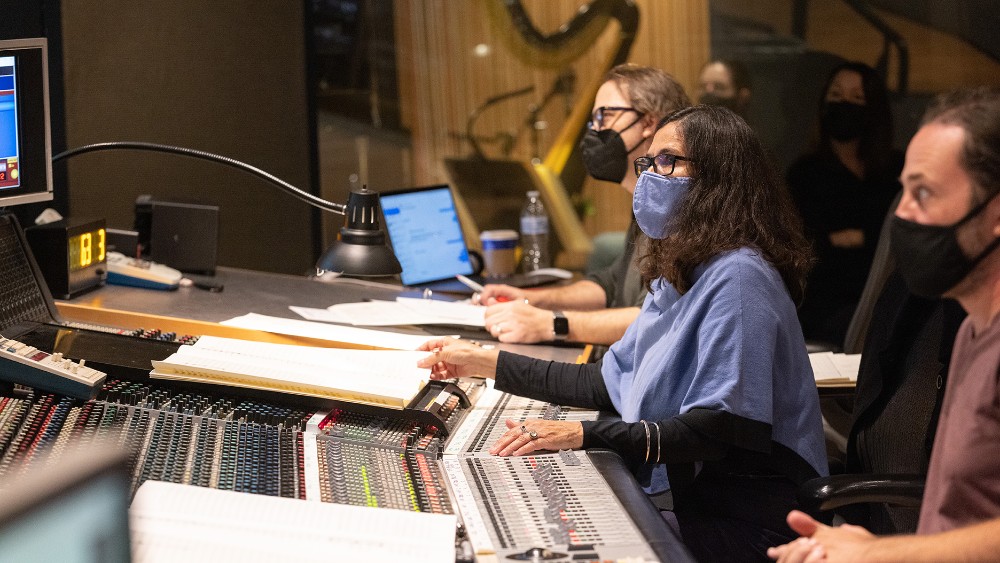
Walt Disney Animation Studios’ 60th film, Encanto, and its first focused on Colombian culture, broke pandemic records for an animated movie and made history in another quirky way. The film’s soundtrack, composed by Germaine Franco, who collaborated on Coco, is the first ever by a woman. [Editor’s Note: Franco’s score was also just nominated for a Golden Globe earlier this week.]
The movie focuses on the Madrigal family and its various members, from the stern but loving Abuela (voiced by María Cecilia Botero) to the quirky, perky Mirabel (Stephanie Beatriz), the only one of the Madrigal family without a gift bestowed upon her relatives by a magic candle. To give the movie its distinctive, playful, emotive score, while sounding both authentic but also faithful to Colombia, Franco had to dig deep into Colombian musical history and styles. The end result was one of the most vivacious soundtracks of any movies this year.
Recently, Below the Line spoke to Franco about what it was like to have made history as Disney’s first female lead composer, about how she learned Colombian style, and more.

Below the Line: Congrats on the beautiful soundtrack. How did you get involved in the project, and how does it feel to make history in this way?
Germaine Franco: Thanks for all the work you do to promote below-the-line equity. I came to the project through Lin Manuel Miranda [the song composer] and also with Tom McDougall, who is now President of Music at Disney and he knew my work from Coco. Jared [Bush] and Byron [Howard], the directors, were also happy to work with me. I am happy to see the work of so many animators, designers, crew, etc. It was so much collaboration in so many fields, and it’s so great when it comes together and works and everybody likes the product. Here, everybody was ecstatic, everyone likes the film. Making history is great, don’t get me wrong, but the collaboration is even more important for me.
BTL: How did you go about preparing the sounds you ended up creating? I’m of Mexican descent, so I heard the sounds in Coco—is that the same for Encanto?
Franco: I’m actually also of Mexican descent, and I’m glad you heard it in Coco. This is obviously different. It is interesting how this web of music in Latin America exists in some form. It’s all a big pool of music from indigenous to the European to the African influences. It exists in some form in each country, but of course, it’s different from country to country. The “cumbia” in Mexico [a sort of Selena type style] is different than the “cumbia” in Colombia. I actually started from the cumbia, because I know that style, and I then said to myself, “Okay, what is an authentic Colombian cumbia, what are the roots?” I listened to over 1,000 hours of music. I watched documentaries and read up a lot, and I’m also a player, so I started to play.
BTL: What do you play?
Franco: I’m a percussionist, but I also play keyboard. I also started playing marimba for the score. The way I went about it was I sat down in front of the piano and working on ideas and themes for each character, thinking about how I wanted to portray each character. The one thing about the main character Mirabel is that she is always on the go, she is very tenacious and does not give up. So the cumbia fit very well for her. I used different Colombian rhythmical dances in the score for different characters. As I was getting into Colombian music, I also used their authentic instruments. I had an authentic Colombian marimba—which is totally different from the Caribbean island ones—made. It arrived in a big box, and it was so awesome. I also had shakers. Having those instruments for the session was nice because we could not go to Colombia due to Covid. I had to do it with the resources available. We also had Colombian harps, called “harpa llanera.” We used drums and flutes.

BTL: Did you collaborate with Colombian artists?
Franco: Absolutely. They were critical for the entire soundtrack. There are a lot of Colombian expats in L.A. actually. I worked with several of them—Justo Armario, J.D. Perez, Rio Benitez. And of course Carlos Vives’ band—he did one of the songs of course, Mi Encanto. His band played at the Hollywood Bowl, and I really love his song. He was here playing a concert, and I asked if we could get some of his musicians for the score. I got Christian Camino Pena, his accordion player. It is very different than the Mexican norteno by the way. It is called “ballenato” style and it is very different than Mexican. Then after I saw Carlos’ band, I asked for a Colombian choir. So one of his lead vocalists, Isabel Mosquera, who was touring with Carlos, she is singing on the one track when Antonio gets the special power and there is that whole tree of life thing. It’s 12 people singing on that particular pew. We also used Latin American players, Peruvian or Uruguayan that know the style. We recorded almost a month, every single day. It was so exciting.
BTL: You mentioned that you had themes for different characters—what are some examples? What tunes did you select and why?
Franco: I started with Mirabel’s theme. Then also a theme for the Encanto home and also the family. You hear that at the beginning of the film, it opens the film when she says: “abre los ojos.” It’s a simple 3/4 feel. That becomes throughout the film attached to Mirabel and her journey. You will hear it in so many different ways throughout the film. I wind up putting that on some action moments when she’s trapped insider the tavern. I then changed elements so it does not sound the same every time. So for example when Antonio gets his gift, I put an Afro-Colombian element called “pierengue” and another one called “mapale.” So you are hearing the Encanto theme on an Afro-Colombian roots. So the theme transforms itself. And when Mirabel gets her own room, you’ll hear the theme at the very end. In its full glory with the orchestra. I really enjoyed being able to morph that theme with the different characters. When Abuela is playing, you hear it very soft with strings.

BTL: Other than Mirabel, which was your favorite character to score and why? You’ve mentioned him twice, so I think I know.
Franco: Yes, little Antonio. He’s a little boy and he’s so special and he has a great presence in the movie. He goes from being afraid to being strong and riding the jaguar and helping Mirabel help the family. I love all the characters, of course. Felix reminds me of a friend of mine. Pepa with the clear skies was very funny. Luisa lifting donkeys, is great. So they are all very unique, and I love them all. But Stephanie Beatriz, the voice of Mirabel, is amazing and she just carries the film. I’m so happy everyone is able to see it and enjoy it with their own families.
BTL: What can we look forward to from you next after this historic achievement?
Franco: I actually can’t talk about it right now! I am working on something, but you will have to wait. I actually took two weeks off after the premiere, but I’m back in the studio getting myself going again and focusing on what is coming up. Reflecting on a great year that I’ve had with this wonderful team on Encanto. Working with Jared, Bryon, and Lin—what an amazing opportunity, right?
BTL: What was it like working with Lin-Manuel and the directors?
Franco: Along the way we had lots of meetings and the feedback was always very encouraging. Lin was very sweet. He was very generous while letting me do my thing and try things. Everyone was happy with how the soundtrack turned out. Their feedback, what it did, was help me work harder. As a musician, it inspires you, especially as you start seeing all the images. It takes you to create the best world you can. Their detail is so amazing, as you can tell, so you want to be just as stellar. And you are seeing the images as they are developing, they are not all done. There were certain scenes that were ready when I started, but it was not until the spring that I was seeing whole reels ready. In some ways that was good as it gave me time to sit away from the picture and just work on themes and motifs. It is nice to have that longer amount of time.
Encanto is now playing in theaters nationwide, and it will hit Disney+ streamer on December 24. You can also read Below the Line’s interview with Co-Director/Co-Writer Charise Castro Smith and read J. Don Birnam’s own review here.
All photos courtesy Walt Disney Pictures.





